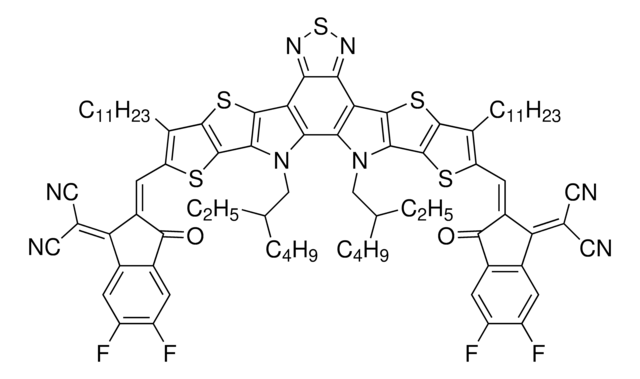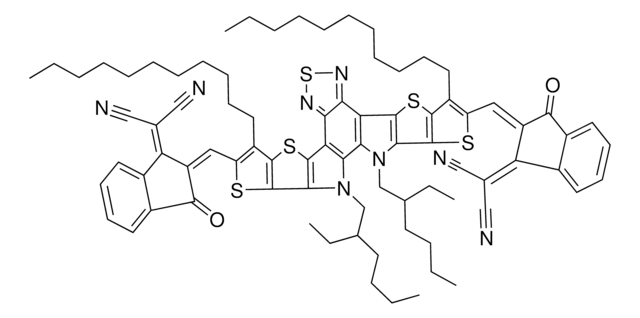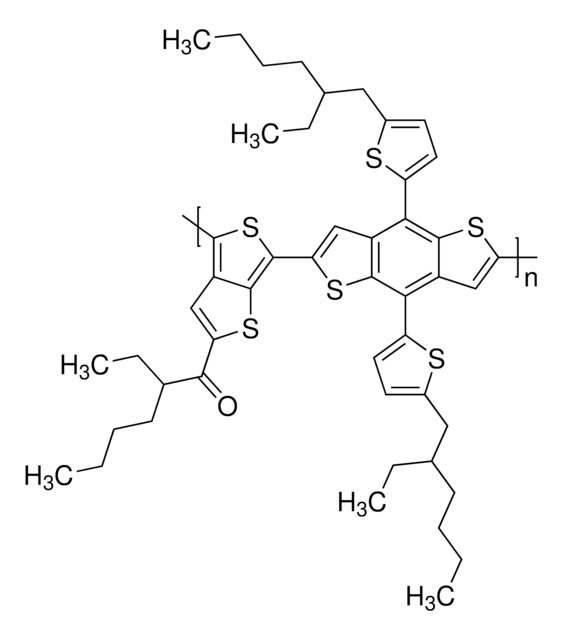772380
DTS(FBTTh2)2
Sinónimos:
7,7′-[4,4-Bis(2-ethylhexyl)-4H-silolo[3,2-b:4,5-b′]dithiophene-2,6-diyl]bis[6-fluoro-4-(5′-hexyl-[2,2′-bithiophen]-5-yl)benzo[c][1,2,5]thiadiazole], F-DTS, p-DTS(FBTTh2)2
About This Item
Productos recomendados
Formulario
solid
solubilidad
chlorobenzene: 0.3-0.5% at 80 °C
dichlorobenzene: 0.3-0.5% at 80 °C
chloroform: soluble(lit.)
dichlorobenzene: soluble(lit.)
λmáx.
590 nm in chloroform
cadena SMILES
CCCCCCc1ccc(s1)-c2ccc(s2)-c3cc(F)c(-c4cc5c(s4)-c6sc(cc6[Si]5(CC(CC)CCCC)CC(CC)CCCC)-c7c(F)cc(-c8ccc(s8)-c9ccc(CCCCCC)s9)c%10nsnc7%10)c%11nsnc3%11
InChI
1S/C64H72F2N4S8Si/c1-7-13-17-19-23-41-25-27-49(71-41)51-31-29-47(73-51)43-33-45(65)57(61-59(43)67-77-69-61)53-35-55-63(75-53)64-56(79(55,37-39(11-5)21-15-9-3)38-40(12-6)22-16-10-4)36-54(76-64)58-46(66)34-44(60-62(58)70-78-68-60)48-30-32-52(74-48)50-28-26-42(72-50)24-20-18-14-8-2/h25-36,39-40H,7-24,37-38H2,1-6H3
Clave InChI
LNMKMESEJYZMDZ-UHFFFAOYSA-N
Descripción general
Aplicación
OPV Device Structure: ITO/MoOx/DTS(PTTh2)2: PC70BM/Al
- JSC = 12.8 mA/cm2
- VOC = 0.81 V
- FF = 0.68
- PCE = 7.0%
Código de clase de almacenamiento
11 - Combustible Solids
Clase de riesgo para el agua (WGK)
WGK 3
Punto de inflamabilidad (°F)
Not applicable
Punto de inflamabilidad (°C)
Not applicable
Elija entre una de las versiones más recientes:
Certificados de análisis (COA)
¿No ve la versión correcta?
Si necesita una versión concreta, puede buscar un certificado específico por el número de lote.
¿Ya tiene este producto?
Encuentre la documentación para los productos que ha comprado recientemente en la Biblioteca de documentos.
Artículos
Solution-processed organic photovoltaic devices (OPVs) have emerged as a promising clean energy generating technology due to their ease of fabrication, potential to enable low-cost manufacturing via printing or coating techniques, and ability to be incorporated onto light weight, flexible substrates.
Active Filters
Nuestro equipo de científicos tiene experiencia en todas las áreas de investigación: Ciencias de la vida, Ciencia de los materiales, Síntesis química, Cromatografía, Analítica y muchas otras.
Póngase en contacto con el Servicio técnico
![[6,6]-Phenyl C71 butyric acid methyl ester 99%](/deepweb/assets/sigmaaldrich/product/structures/716/624/9fb9f2f0-ae99-429f-8d3a-b12267976a4d/640/9fb9f2f0-ae99-429f-8d3a-b12267976a4d.png)




![Poly[4,5-difluoro-2,2-bis(trifluoromethyl)-1,3-dioxole-co-tetrafluoroethylene] dioxole 87 mol %](/deepweb/assets/sigmaaldrich/product/structures/951/320/21327fcd-4960-402d-8ae1-bf2e379cb2e2/640/21327fcd-4960-402d-8ae1-bf2e379cb2e2.png)


